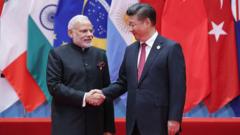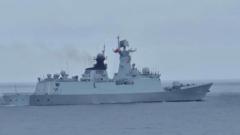In the wake of an intense air skirmish between India and Pakistan, analysts are closely examining the ramifications for China's military capabilities and its assertive posture in the South China Sea and towards Taiwan.
China's Military Gains: Insights from the India-Pakistan Air Clash

China's Military Gains: Insights from the India-Pakistan Air Clash
An analysis of the recent conflict reveals how Chinese military assets are influencing regional dynamics, particularly concerning Taiwan.
In early May 2025, Pakistan's air force claimed a notable achievement, stating it shot down several Indian aircraft, asserting its success was made possible by Chinese-made J-10C fighter jets and advanced air-to-air missiles. This four-day conflict has sent strong signals throughout Asia, particularly in areas where tensions with China remain high.
As the conflict unfolded, Beijing's state media and military commentators proclaimed a vindication for the J-10C jets. Described by some as a “fighter of national pride,” the J-10C had previously been an essential part of Chinese military exercises designed to demonstrate strength over Taiwan, a territory China seeks to unify under its governance.
Despite the absence of official confirmation by either the Chinese government regarding the specific successes claimed by Pakistan or Indian authorities acknowledging the losses, the Chinese narrative is gaining traction. A Chinese state broadcaster, celebrating the jets’ perceived combat effectiveness, highlighted their “combat results for the first time,” in context with claims linked to the recent hostilities.
Retired Chinese military officials have begun to speculate that the success of the J-10C could embolden China's assertive stance in future confrontations over territories it considers essential, such as Taiwan and the South China Sea, reinforcing nationalistic sentiments across China and giving it leverage in regional security dynamics.
This newfound confidence, however, must still be tempered with the recognition of air combat complexity, as the ramifications of the India-Pakistan clash reveal a changing landscape in military capabilities and regional alliances.
As the conflict unfolded, Beijing's state media and military commentators proclaimed a vindication for the J-10C jets. Described by some as a “fighter of national pride,” the J-10C had previously been an essential part of Chinese military exercises designed to demonstrate strength over Taiwan, a territory China seeks to unify under its governance.
Despite the absence of official confirmation by either the Chinese government regarding the specific successes claimed by Pakistan or Indian authorities acknowledging the losses, the Chinese narrative is gaining traction. A Chinese state broadcaster, celebrating the jets’ perceived combat effectiveness, highlighted their “combat results for the first time,” in context with claims linked to the recent hostilities.
Retired Chinese military officials have begun to speculate that the success of the J-10C could embolden China's assertive stance in future confrontations over territories it considers essential, such as Taiwan and the South China Sea, reinforcing nationalistic sentiments across China and giving it leverage in regional security dynamics.
This newfound confidence, however, must still be tempered with the recognition of air combat complexity, as the ramifications of the India-Pakistan clash reveal a changing landscape in military capabilities and regional alliances.



















